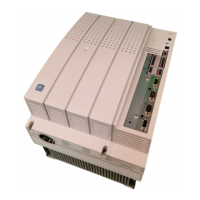Installation
4-11
BA9300SU EN 2.1
4.2.2 Protection of the controller
Stop!
The controllers contain electrostatically sensitive components.
• Prior to assembly and service operations, the personnel must be free of electrostatic charge:
– Discharge by touching the PE fixing screw or another grounded metal part in the control
cabinet.
• Length of the screws for the connection to the screen cable/screen plate for the types 9327
to 9332: < 12 mm
• Controller protection by means of external fuses. (
^
3-6)
• Protect unused control inputs and outputs with plugs or covers (included in the contents of
delivery) for the Sub-D inputs.
• Frequent mains switching can overload the internal switch-on current limitation. For cyclic
mains switching, the controller can be switched on every three minutes as a maximum.
• The controllers 9324, 9326, 9328 and 9329 must only be operated with the appropriate mains
filters.
(
^
3-7)
• In case of condensation, connect the controller to the mains voltage only after the visible
humidity has evaporated.
4.2.3 Motor protection
• Complete motor protection according to VDE:
– By overcurrent relays or temperature monitoring.
– Required for group drives (motors connected in parallel to a controller)
– We recommend the use of PTC thermistors or thermostats with PTC characteristic to
monitor the motor temperature.
Stop!
Asstandard Lenze three-phase ACmotors are equipped with PTCthermistors. Ifmotors from other
manufacturers are used, carry out all steps required for the adaptation to the controller.
(
^
4-28)
• When using motors with insulation which is not suitable for inverter operation:
– Please contact your motor supplier.
Lenze AC motors are designed for inverter operation.
• With the corresponding parameter setting, the controllers generate field frequencies up to
600 Hz:
– With motors not suited for the application, dangerous overspeeds may occur and destroy
the drive.

